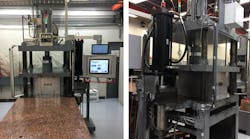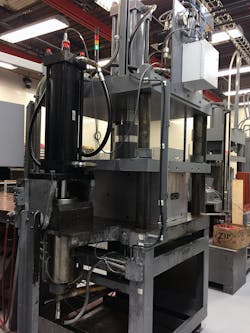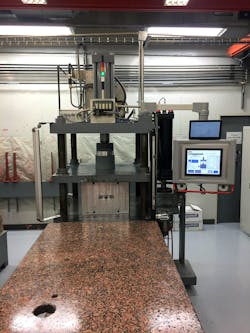In aluminum investment casting, a disposable wax pattern must be made for each part to be formed from molten aluminum. To make those wax patterns, low-temperature paste wax is injected into cavity molds. To get a high-quality pattern, the cavity must be completely filled so that no air is trapped in the mold, which leaves a bubble or void in the final pattern. Therefore, the flow of paste wax must be controlled so entrapped air can escape through vents in the mold.
The challenges to doing this are well-known to engineers at Solidiform Inc. of Fort Worth, Tex., a leader in producing aluminum investment and precision sand castings for the aerospace industry. The company recently upgraded its wax injection system and had a few requests of the engineers working on the upgrade.
“When the mold was nearly filled, we wanted the machine to slow the filling rate to let air exit,” says Solidiform’s vice president and general manager, Larry Andre. “The problem with our old wax extruder was that we couldn’t manually change the flow rate during injection, so we were forced to pick a compromise filling rate.”
As a result, some air was often left in the mold, creating voids in the wax pattern that had to be repaired before the pattern could be used in the next stage of the process.
Black cylinder (upper left) compresses the hot wax. The cylinder (top center) clamps the mold closed against the injection nozzle on the stationary platen.
Automating the Operation
With the goal of avoiding this rework and making the process more repeatable, Solidiform’s management looked for a way to control how wax fills the mold. A few solutions were attempted, including manual flow-control valves and electronically-controlled pressure regulators, all with limited success. To solve the problem, they contacted the Wilson Company, a fluid power distributor throughout Texas, headquartered in Addison.
Wilson engineer Dave Pellerin recommended that an electrohydraulic motion controller for the cylinder that operates the wax extruder would give them precise control. Pellerin recommended Solidiform use the RMC75E from Delta Computer Systems, Inc. of Battle Ground, Washington.
At the beginning of the process, a wax billet is loaded into the extruder cylinder with the temperature maintained by heater bands on the exterior. The extruder cylinder then forces warm wax through a heated hose to fill the mold, which is held closed by the clamp cylinder. The motion controller uses setpoints entered from a database for injection velocity and pressure to ensure a consistent fill.
The wax’s compressibility is different from that of air, and the control system monitors and adjusts for this by reading the output of a pressure transducer in the wax line. Using this information, the injection pressure can be dynamically changed as the mold fills.
The controller reacts to pressure changes by increasing or decreasing its command to the servo control valve. As soon as air is evacuated, the pressure almost immediately returns. By this time, the controller must respond quickly by lowering the command voltage back to the appropriate level (and hence reducing the flow of hydraulic fluid to the injector cylinder) to minimize overshoot. The motion controller also compensates for viscosity differences in the wax from one production run to another. The controller ensures set pressure is exact and repeatable from shot to shot.
The Delta motion controller monitors piston pressure and position in each cylinder. The control algorithm employed is called “dual loop control.” The inner control loop ensures the position and velocity of the piston matches the profile as it injects wax, while the outer loop verifies that the pressure exerted as the piston moves does not exceed set limits.
All injection functions are coordinated using a Red Lion touchscreen, the primary operator interface. The HMI also interfaces with an Allen-Bradley PLC, which controls power unit sequencing and safety mechanisms.
After the injection cycle is complete, the RMC75E creates a slight negative pressure in the wax line as the clamping cylinder retracts. This ensures no residual wax squirts out as clamp pressure is removed. All pressure values are displayed on the HMI.
The operation of the press is controlled and monitored on a Red Lion control panel. All injection functions are coordinated using the touchscreen, the primary operator interface.
Programming the Motion
To make it easier to tune the motion parameters, Delta provides a software tool, the Plot Manager, part of the company’s RMCTools software interface. Plots produced by this module display values of actual motion parameters rather than target values calculated by the control loop algorithm. The plots let them chart expected activities such as:
- Time 0 to 10 sec.: Wax is injecting. There is too much air in the mold to read any back pressure.
- At 10 sec.: A quick pressure bump. The mold is starting to fill, so pressure is measured. However, it quickly dissipates as an entrapped air bubble appears.
- At 10.75 sec.: A sharp rise in pressure as the last of the air is pushed out and the mold fills. The control command voltage is too high because readings are not real, but the controller quickly responds to steady the output. Once all the air is pushed out and the mold is completely full of wax, it takes approximately 0.1 sec. to pressurize wax in the mold.
- At 11 sec.: Pressure begins to steady out and is held at its setpoint for the duration of the cycle, letting the wax solidify under pressure.
Plots such as these can be used to diagnose motion problems. For example, before final tuning, the plots showed some chattering in the system (oscillations in cylinder position). It was caused by the extruder going from injecting wax to encountering an entrapped air bubble. To resolve the problems, Delta’s support team was called in to recommend some tweaks to the system that leveraged the controllers’ fast loop times and advanced tuning parameters, along with the addition of a low-pass output filter that tuned out those oscillations.
“Now, the Delta controller can give us a variable flow rate, tailored to the part we want to make,” says Andre. “And it can maintain the pressure precisely and repeatably, there’s no guesswork. By controlling the mold fill rate, and not letting imperfections form, we have easily increased our first-time pattern yield and we don’t need to do any repairs. We’ve probably increased productivity by 20%.”
Jason Palmer is a regional applications engineer at Delta Computer Systems Inc. Delta Computer Systems designs and manufactures electrohydraulic motion controllers with applications worldwide. For more information, contact the company at 360-254-8688 or visit its website.



